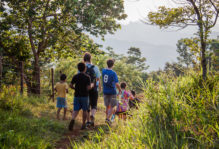Persistence and Partnering. 2/27/14
The MANOS advance team (Johnathan Maza ’15; 5th project trip); Stephanie Wraith ’15, fourth project trip; Sarah Martin ’17, 1st project trip; and me, 8th project trip) met with Dr. Benito Blanco, Medical Director of the MINSA clinic in Totogalpa, Nicaragua. We summarized our medical and community efforts over the past seven years in Cuje (micro-region) and the community of Chaguite. Dr. Blanco expressed appreciation for these efforts—and some mild aggravation about the lack of coordination of our efforts with his office. He noted that our clinic has been helpful but could be more effective through such coordination. We agree—and we are encouraged by his perspective. We’ve been urging that point of view since 2007. There are several plausible explanations for and possibly contributing factors to the lack of effective partnering to date. It is likely, for example, that for the first several years the local medical professionals saw no reason to believe that we would keep coming. There was a different clinic director when we began. He’s now the mayor of the municipality of Totogalpa. And, when we began, the region was in a deep drought and even the most meager of resources had dried up. At that time, we found the clinic woefully under-staffed and with the most minimal medicines and equipment. There was a “siege” kind of feeling about the operation and the clinic staff seemed more than satisfied for us to do anything—without much consideration of strategic advantages.
The entire region has seen remarkable improvements over the last several years: more rain, resurgence of flora and fauna following the transformation of the ecology through clear-cutting of the evergreen forests, a relatively stable government, and increased presence and investment of national and international NGOs. Like the clinic, the mayor’s office, where we met with the Sub-mayor and the General Secretary of Community Cabinets, the facilities were in good repair and had an air of organizational efficiency that clearly was absent when we visited earlier.
It seems likely that these things have contributed most to the current moment for engagements: (1) Success by Dr. Blanco and his colleagues and staff in gaining and using resources to achieve organizational and professional goals; (2) the increase in NGO presence in the area, leading to a sense of need and possibility for strategic arrangements; and (3) our persistence in returning to the area.
We do not quibble with Dr. Blanco’s view that more can be done through better collaboration. That, essentially, is our mantra.
We met also with officials in the mayor’s office. We heard a similar message and we embraced that with equal enthusiasm. We deserve and take no credit for their (seemingly) increased enthusiasm to partner—other than our persistent effort to learn from them how we can best work with them to partner with communities to improve health and health care. Readiness to partner involves more than one potential participant. And, in the current era of volunteering, service, service learning, engaged scholarship, action research, and participatory development, it seems necessary to establish proper creds in order to expect authentic discussions about the role that might be played by outsiders.




No comments.
Comments are currently closed. Comments are closed on all posts older than one year, and for those in our archive.